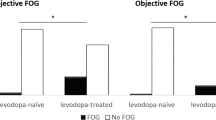Abstract
To compare the effects of intravenous amantadine and placebo therapy on freezing of gait in patients with Parkinson’s disease, this randomized, double-blind, placebo-controlled, multicenter trial compared the efficacy of 5 days intravenous amantadine and placebo treatments on freezing of gait in 42 subjects randomly allocated 2:1 to amantadine or placebo groups. Changes in freezing of gait questionnaire (FOG-Q) scores and in unified Parkinson’s disease rating scale (UPDRS) scores, from baseline to immediately (V1) and 1 month (V2) after treatments, were assessed. Among the 42 patients (amantadine n = 29, placebo n = 13, a mean age 65.5 ± 9.4 years and a mean FOG-Q score 17.4 ± 3.2), 40 subjects completed treatment. There was no significant group difference on the primary outcome measure as total FOG-Q score changes at V1. However a significant beneficial effect of amantadine on freezing was seen at V2 in the UPDRS Part II freezing and FOG-Q item 3 scores, and there was significant improvement in the UPDRS Part IV total score and in the UPDRS Part II getting out of bed score in the amantadine group at both V1 and V2. There was no serious adverse event reported during the study. The intravenous amantadine therapy did not show a significant improvement on overall FOG-Q scores in patients with moderate-to-severe freezing; however, it might be beneficial by attenuating freezing severity and improving patients’ mobility. To prove this finding further studies with larger sample sizes are warranted in the future.



Similar content being viewed by others
References
Schwab RS, England AC Jr, Poskanzer DC, Young RR (1969) Amantadine in the treatment of Parkinson’s disease. JAMA 208:1168–1170
Parkes JD, Calver DM, Zilkha KJ, Knill-Jones RP (1970) Controlled trial of amantadine hydrochloride in Parkinson’s disease. Lancet 1:259–262
Lupp A, Lucking CH, Koch R, Jackisch R, Feuerstein TJ (1992) Inhibitory effects of the antiparkinsonian drugs memantine and amantadine on N-methyl-D-aspartate-evoked acetylcholine release in the rabbit caudate nucleus in vitro. J Pharmacol Exp Ther 263:717–724
Blanpied TA, Clarke RJ, Johnson JW (2005) Amantadine inhibits NMDA receptors by accelerating channel closure during channel block. J Neurosci 25:3312–3322
Lange KW, Kornhuber J, Riederer P (1997) Dopamine/glutamate interactions in Parkinson’s disease. Neurosci Biobehav Rev 21:393–400
Okuma Y (2006) Freezing of gait in Parkinson’s disease. J Neurol 253(supp7):VII27–VII32
Giladi N (2008) Medical treatment of freezing of gait. Mov Disord 23(supp 2):S482–S488
Devos D, Defebvre L, Bordet R (2010) Dopaminergic and non-dopaminergic pharmacological hypotheses for gait disorders in Parkinson’s disease. Fundam Clin Pharmacol 24:407–421
Skuza G, Rogoz Z, Quack G, Danysz W (1994) Memantine, amantadine, and l-deprenyl potentiate the action of l-dopa in monoamine-depleted rats. J Neural Transm Gen Sect 98:57–67
Giladi N, Treves TA, Simon ES et al (2001) Freezing of gait in patients with advanced Parkinson’s disease. J Neural Transm 108:53–61
Kondo T (2006) Drug intervention for freeizng of gait resistant to dopaminergic therapy: a pilot study. Parkinsonism Relat Disord 12:S63–S66
Kim YE, Yun JY, Jeon BS (2011) Effect of intravenous amantadine on dopaminergic-drug- resistant freezing of gait. Parkinsonism Relat Disord 17:491–492
Kim YE, Yun JY, Yang HJ et al (2012) Intravenous amantadine for freezing of gait resistant to dopaminergic therapy: a randomized, double-blind, placebo-controlled, crossover clinical trial. PLoS One 7(11):e48890
Hughes AJ, Daniel SE, Kilford L, Lees AJ (1992) Accuracy of clinical diagnosis of idiopathic Parkinson’s disease: a clinico-pathological study of 100 cases. J Neurol Neurosurg Psychiatry 55:181–184
Giladi N, Shabtai H, Simon ES, Biran S, Tal J, Korczyn AD (2000) Construction of freezing of gait questionnaire for patients with parkinsonism. Parionsonism Relat Disord 6:165–170
Růzicka E, Streitová H, Jech R et al (2000) Amantadine infusion in treatment of motor fluctuations and dyskinesias in Parkinson’s disease. J Neural Transm 107:1297–1306
Del Dotto P, Pavese N, Gambaccini G et al (2001) Intravenous amantadine improves levodopa-induced dyskinesias: an acute double-blind placebo-controlled study. Mov Disord 16:515–520
Pinter MM, Birk M, Helscher J, Binder H (1999) Short-term effect of amantadine sulphate on motor performance and reaction time in patients with idopathic Parkinson’s disease. J Neural Transm 106:711–724
Muller T, Kuhn W, Schulte T, Przuntek H (2003) Intravenous amantadine sulphate application improves the performance of complex but not simple motor tasks in patients with Parkinson’s disease. Neurosci Lett 339:25–28
Inzelberg R, Bonuccelli U, Schechtman E et al (2006) Association between amantadine and the onset of dementia in Parkinson’s disease. Mov Disord 21:1375–1379
Amboni M, Cozzolino A, Longo K, Picillo M, Barone P (2008) Freezing of gait and executive functions in patients with Parkinson’s disease. Mov Disord 23:395–400
Müller T, Kuhn W, Quack G, Przuntek H (1995) Intravenous application of amantadine and antiparkinsonian efficacy in Parkinsonian patients. J Neural Transm Suppl 46:407–413
Brenner M, Haass A, Jacobi P, Schimrigk K (1989) Amantadine sulphate in treating Parkinson’s disease: clinical effects, psychometric tests and serum concentrations. J Neurol 236:153–156
Espay AJ, Fasano A, van Nuenen BF, Payne MM, Snijders AH, Bloem BR (2012) “On” state freezing of gait in Parkinson disease: a paradoxical levodopa-induced complication. Neurology 78:454–457
Acknowledgments
This study is partially supported by the grant of National Research Foundation of Korea (NRF) funded by the Ministry of Education, Science and Technology (2011-0014451). The investigational drugs were unconditionally sponsored by Hanwha Pharmaceuticals.
Conflicts of interest
There is no conflict of interest.
Author information
Authors and Affiliations
Corresponding author
Additional information
Trial registration Clinical Trials NCT01313845.
Electronic supplementary material
Below is the link to the electronic supplementary material.
Rights and permissions
About this article
Cite this article
Lee, J.Y., Oh, S., Kim, J.M. et al. Intravenous amantadine on freezing of gait in Parkinson’s disease: a randomized controlled trial. J Neurol 260, 3030–3038 (2013). https://doi.org/10.1007/s00415-013-7108-7
Received:
Revised:
Accepted:
Published:
Issue Date:
DOI: https://doi.org/10.1007/s00415-013-7108-7




